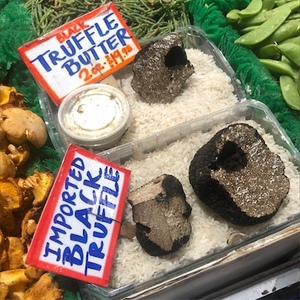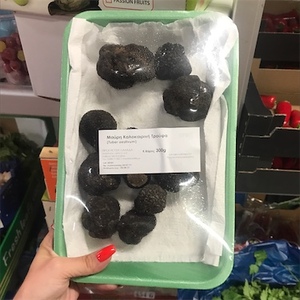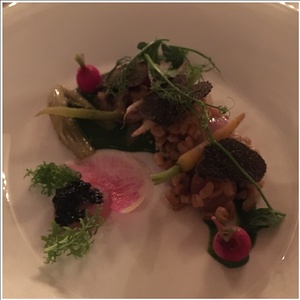


Asian Black Truffles
Estimated Inventory, lb : 0
Description/Taste
Asian Black truffles vary in size and shape depending on growing conditions, but are generally small, averaging 2 to 5 centimeters in diameter, and have a knobbed and lopsided, globular appearance. The black-brown fungi are typically molded by stones in the soil and have a textured surface, covered in many small protrusions, bumps, and crevices. Underneath the rough exterior, the flesh is spongy, black, and rubbery, marbled with sparse, thin white spider veining. Asian Black truffles will have a more elastic consistency than European black truffles and a slightly darker coloring, containing less veining. Asian Black truffles bear a faint, musky aroma, and the flesh has a mild, earthy, and woody flavor.
Seasons/Availability
Asian Black truffles are available in the late fall through early spring.
Current Facts
Asian Black truffles are a part of the Tuber genus and are also known as Chinese Black truffles, Himalayan Black truffles, and Asian Winter Black truffles, belonging to the Tuberaceae family. There are many different species of truffles found within the Tuber genus, and the name Asian Black truffle is a general descriptor used to describe a few of these Tuber species collected in Asia. Tuber indicum is the most prevalent species of Asian Black truffles, documented since the 1980s, but as scientists began to study the molecular structures of the fungi, they discovered there were other closely related species, including Tuber himalayense and Tuber sinensis. Asian Black truffles have been growing naturally for thousands of years, but the truffles were not viewed as a commercial commodity until the 1900s. During this time, the European truffle industry struggled to keep up with demand, and Chinese companies began exporting Asian Black truffles to Europe as a substitute for the European black winter truffles. A truffle boom soon occurred throughout Asia, especially in China, and the small truffles were rapidly being shipped into Europe, making it difficult for European governments to regulate the truffles. With a lack of regulation, some companies began selling Asian Black truffles under the rare European perigord truffle name at high prices, causing widespread controversy among truffières across Europe. Asian Black truffles are incredibly similar in appearance to the famous European black truffles, but they lack the signature aroma and flavor. Counterfeiters mix Asian Black truffles with true perigord truffles to compensate for the lack of fragrance, allowing the Asian Black truffles to absorb the signature scent to make the truffles almost indistinguishable. In the modern-day, there is still heated controversy surrounding the quality of Asian Black truffles compared to the European truffles, and truffles must be purchased through trusted sources.
Nutritional Value
Asian Black truffles provide vitamin C to strengthen the immune system, boost collagen production, and reduce inflammation. The truffles are also a source of antioxidants to protect the body against free radical damage and contain lower amounts of zinc, iron, magnesium, calcium, fiber, manganese, and phosphorus. In traditional Chinese medicine, black truffles have been used medicinally to restore the appetite, rejuvenate and detox organs, and balance the body.
Applications
Asian Black truffles are best used sparingly in raw or lightly heated applications, typically shaved, grated, slivered, or thinly sliced. The truffle's mild, musky, and earthy flavor complements dishes with fatty, rich elements, wine or cream-based sauces, oils, and neutral ingredients such as potatoes, rice, and pasta. The truffles should be cleaned before use, and it is recommended to brush or wipe the surface rather than rinsing under water as moisture will cause the fungus to rot. Once cleaned, Asian Black truffles can be shaved fresh as a finishing flavor over pasta, roasted meats, risottos, soups, and eggs. In China, Asian Black truffles are becoming increasingly popular among the upper class, and the truffles are being incorporated into truffle sushi, soup, sausages, and dumplings. Chefs are also infusing Asian Black truffles into cookies, liquors, and mooncakes. Worldwide, Asian Black truffles are folded into butter, infused into oils and honey, or grated into sauces. Asian Black truffles pair well with meats such as lamb, poultry, venison, and beef, seafood, foie gras, cheeses such as goat, parmesan, fontina, chevre, and gouda, and herbs such as tarragon, basil, and arugula. Fresh Asian Black truffles will keep up to one week when wrapped in a paper towel or moisture absorbent cloth and stored in a sealed container in the refrigerator's crisper drawer. It is important to note that the truffle should remain dry for the best quality and flavor. If keeping for more than a couple of days, replace the paper towel regularly to prevent moisture build-up as the fungus will naturally release moisture as it is stored. Asian Black truffles can also be wrapped in foil, placed in a freezer bag, and frozen for 1 to 3 months.
Ethnic/Cultural Info
Asian Black truffles are primarily harvested in the Yunnan province of China. Historically, the small, black truffles were not consumed by local villagers and were given to pigs as animal feed. In the early 1990s, truffle companies arrived in Yunnan and began sourcing Asian Black truffles for export to Europe to compete with the flourishing perigord truffle market. With the demand for truffles increasing, Yunnan farmers quickly took to harvesting the truffles from the surrounding forests. Asian Black truffles grow naturally at the base of trees, and the original truffle harvests were abundant in Yunnan, creating a fast and efficient source of income for families. Yunnan farmers commented that collecting truffles doubled their yearly income, and the process requires little to no upfront costs, as the truffles grow naturally without human assistance. Despite the prosperous business for the villagers, unlike Europe, where truffle collecting is strictly regulated, much of the truffle harvests are left unregulated in China, causing extensive overharvesting. Chinese truffle hunters use toothed rakes and hoes to dig approximately 30 centimeters into the earth around the base of trees to uncover the truffles. This process disrupts the soil composition surrounding the trees and exposes the tree roots to the air, which can damage the symbiotic connection between the fungi and the tree. Without this connection, new truffles will cease to grow for future harvests. Experts worry that the overharvest of Asian Black truffles in China is setting the country up for failure in the future as many forests that once contained truffles are now barren, no longer producing any fungi due to habitat disruption. Many Asian Black truffles are also gathered on state land, leading hunters to scramble and harvest the truffles early before other hunters can take the truffles. This has led to an influx of immature truffles sold in markets with less flavor and a rubbery texture.
Geography/History
Asian Black truffles have been naturally growing near and under pine trees and other conifer trees throughout Asia since ancient times. The winter truffles can be found in regions of India, Nepal, Tibet, Bhutan, China, and Japan, and the truffles generally begin fruiting when the host plants are at least ten years old. Asian Black truffles were not widely collected until the early 1990s when farmers began exporting the truffles to Europe. Since the 1990s, the harvesting of Asian Black truffles has continued to rise, increasing the number of hunters searching for the truffles throughout Asia. In China, Asian Black truffles are primarily harvested from the Sichuan and Yunnan provinces, with Yunnan producing over seventy percent of the black truffles sold domestically and internationally. Asian Black truffles are also found in smaller quantities in the Liaoning, Hebei, and Heilongjiang provinces, and select farms are attempting to cultivate Asian Black truffles for commercial use. Today Asian Black truffles are shipped internationally to Europe and North America. The truffles are also utilized domestically and are mainly shipped to high-end restaurants in larger cities, including Guangzhou and Shanghai.
Recipe Ideas
Recipes that include Asian Black Truffles. One











